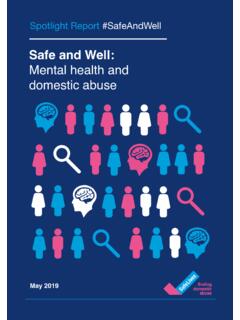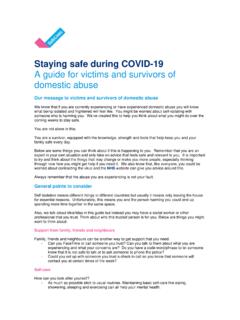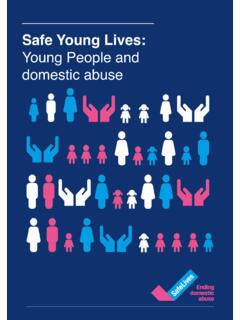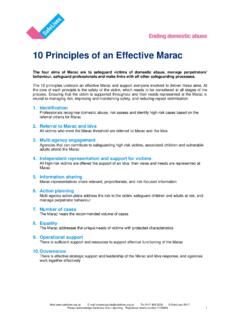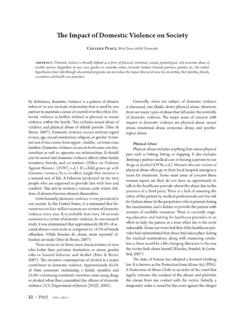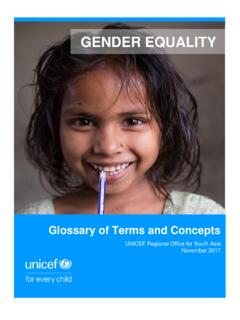Transcription of Safe Later Lives: Older people and domestic abuse
1 ## October 2016 Spotlights Report #HiddenVictimsSafe Later Lives: Older people and domestic abuseAcknowledgementsThank you to Age UK for helping to shape this first Spotlights on Older people and domestic abuse . Thanks are also due to all of the practitioners, victims and policy experts who contributed to this report. Finally, grateful thanks to Abigail Munroe for her work on drafting the final 3 ContentsBackground 4 The scale of the problem 5 Key Findings 101. Systematic Invisibility 112. Long term abuse and dependency issues 133. Generational attitudes about abuse may make it hard to identify 154. Increased risk of adult family abuse 165. Services are not effectively targeted at Older victims, and do not always meet their needs 176. Need for greater coordination between services 19 Policy and Practice Recommendations 221.
2 Systematic Invisibility 222. Long term abuse and dependency issues 223. Generational attitudes about abuse may make it hard to identify 234. Increased risk of adult family abuse 235. Services are not effectively targeted at Older victims, and do not always meet their needs 246. Need for greater coordination between services 25 Notes 26 BackgroundDomestic abuse is a complex, wide reaching and largely hidden phenomenon. Each year, around million people suffer from domestic abuse in England and Wales million women ( of the population) and 700,000 men ( of the population).1 Crucially, 85% of victims made five attempts on average to get support from professionals in the year before they accessed effective help to stop the Whilst the impact of domestic abuse is grave on all victims, certain groups experience additional challenges and barriers.
3 Many surveys and studies, such as the Crime Survey for England and Wales, have excluded consideration for victims aged 60 plus,3 and awareness raising campaigns have consistently focused on younger victims and This serves to reinforce the false assumption that abuse ceases to exist beyond a certain age. The limited pool of research which does exist on domestic abuse and Older people suggests that Older women s experiences of domestic abuse are markedly different from those in younger age groups and that these differences have not been adequately acknowledged or accounted for .5 This report provides a focus on this historically hidden group, which is essential to tailoring appropriate and effective services for victims (and perpetrators). The report is part of the SafeLives Spotlights series, which will focus on hidden groups of domestic abuse victims throughout 2016 and 2017 and propose recommendations for both practitioners and policymakers.
4 The first Spotlights has focused on Older victims of abuse and involved a survey with 27 professionals, feedback from survivors, frontline practitioners and policymakers, as well as webinars and a social media Q& 5 The scale of the problemWhat do we know about Older victims of domestic abuse ?Although there is no widely accepted prevalence data for this age group, we estimate that in the last year approximately 120,000 individuals aged 65+ have experienced at least one form of abuse (psychological, physical, sexual or financial).6 Although Marac (Multi-Agency Risk Assessment Conferences) data does not include this age bracket, figures show that only 3% of victims aged 60 or over are accessing Idva services supported by the Marac of clients60 and underOver 60 Perpetrator is current partner 28%40%Male clients4%21%Adult family member is the primary perpetrator6%44%Multiple perpetrators 9%7%Attempted to leave the perpetrator 68%27%Average length of abuse4 years yearsPhysical health & mental health6 & 76 & 6 Physical abuse69%69%Sexual abuse 25%10%Harassment and stalking73%57%Jealous and controlling behaviours 83%73%IDVAI ndependent domestic violence AdvisorSafe Later Lives: Older people and domestic abuse6 Policy and legislative contextTo varying extents, domestic abuse has been included in policy since the mid-1970s.
5 Due to its multi-faceted nature, public policy responses to domestic abuse feature within a number of areas. Provisions can be seen across housing, health, education, security and social services, as well as civil and criminal law. Consistently, Older women do not benefit from generic policy provision, as they require more tailored responses to fit their needs and experiences. As is stated by the Government s Ending violence Against Women and Girls strategy (2016 2020) there is no generic approach to providing services to victims of violence and abuse . Needs may be complex and may include, for example, housing provision, Victims aged 61+ are much more likly to experience abuse from an adult family member than those 60 and aged 61+ are much more likly to experience abuse from a current intimate partner than those 60 and victims are more likely to be living with the prepetrator after getting victims are significantly more likely to have a disability for a third, this is physical (34%).
6 60 years old61+ years old32%9% 60 years old61+ years old44%6% Older victims are less likely to attempt to leave their perpetrator in the year before accessing help. 60 years old61+ years old27%68% 60 years old61+ years old48%13%34% 60 years old61+ years old40%28%Spotlights: Older victims of domestic abuseSafeLives 7assistance with debt or support for mental health problems. Provision should meet the needs of the diverse range of victims whether long term residents of that locality or victims who have moved in more recently .8 In this strategy, Older women are highlighted as a specific group whose needs must be assessed by the Transformation Fund after its launch in April 2017. They are described as forming a group that experience multiple disadvantage .9 Guidance issued by the Local Government Association (LGA) and association of directors of adult social services (Adass)10 sets out key UK legislation which provides the basis for safeguarding Older people experiencing domestic Statutory Guidance issued under the Care Act, published in October 2014, states that adult safeguarding means protecting an adult s right to live in safety, free from abuse and neglect (Section ).
7 Safeguarding duties apply to an adult who: has needs for care and support (whether or the not the authority is meeting any of those needs) is experiencing, or is at risk of, abuse or neglect as a result of those care and support needs is unable to protect themselves from either the risk of, or the experience of abuse or neglect . (Section )The Care Act specifies that freedom from abuse and neglect is a key aspect of a person s wellbeing. The guidance outlines that abuse takes many forms, and local authorities should not be constrained in their view of what constitutes abuse or neglect. It describes the following types of abuse , which include exploitation as a common theme: Physical abuse domestic violence Sexual abuse Psychological abuse Financial or material abuse Modern slavery Discriminatory abuse Organisational abuse Neglect and acts of omission Self-neglectIt also states that abuse and neglect can be caused deliberately or unintentionally.
8 domestic violence is a category of abuse which was added to the existing list of categories following consultation on the draft Care Act Later Lives: Older people and domestic abuse8 Financial abuse has also been highlighted further in the Care Act guidance following consultation as the signs can present differently from other more physical signs of abuse . This needs to be considered in the context of domestic abuse within this guide. The guidance outlines that the aims of adult safeguarding are to: Stop abuse or neglect wherever possible Prevent harm and reduce the risk of abuse or neglect to adults with care and support needs Safeguard adults in a way that supports them in making choices and having control about how they want to live Promote an approach that concentrates on improving life for the adults concerned Raise public awareness so that communities as a whole, alongside professionals, play their part in preventing, identifying and responding to abuse and neglect Provide information and support in accessible ways to help people understand the different types of abuse , how to stay safe and what to do to raise a concern about the safety or well-being of an adult Address what has caused the abuse or neglect.
9 (Section )There are no separate policy statements from national Government on the issue of Older people and domestic abuse , though the violence Against Women and Girls strategy (2016 2020) includes Older people within the groups of victims who the Government will support through improved commissioning: We recognise that some sectors of society can experience multiple forms of discrimination and disadvantage or additional barriers to accessing support. These include women and girls from Black and Minority Ethnic (BME) communities, lesbian, gay, bisexual and transgender (LGB&T) women, Older women and disabled women, adults who seek help for childhood sexual abuse , and the needs of female offenders who have also been victims of violence and abuse . Our support to promote effective local commissioning will focus on ensuring the needs of all victims are met. 11 SafeLives 9 WalesIn Wales, the Government has launched a consultation on guidance for Older people and domestic The Welsh Government s National Adviser for violence Against Women recently published an Annual Plan which recognised the need for greater understanding of the needs and the evidence base for interventions and models of support for Older Scottish Government has recently passed the Abusive Behaviour and Sexual Harm Among other measures, the Bill provides a new specific domestic abuse aggravator that identifies an aggravated offence if the crime involves abuse of the offender s partner or ex-partner.
10 This followed the publication of the Government s Strategy for Preventing and Eradicating violence Against Women and Girls in The strategy did not mention Older victims specifically, but did cite figures which suggested younger adults were more likely to have experienced abuse by a partner in the last 12 months from the Scottish Crime and Justice Later Lives: Older people and domestic abuse10 Key FindingsMany of the problems facing Older victims are common to all of those experiencing domestic abuse . However, Older victims experiences are often exacerbated by social, cultural and physical factors that require a tailored response. Our Insights dataset shows that clients over 60 are less likely to have attempted to leave than those under (17% vs 29%). This report has identified the following six key findings from the Spotlights investigation (July and August 2016).Finding 1 Systematic invisibility Finding 2 Long term abuse and dependency issues Finding 3 Generational attitudes about abuse may make it hard to identifyFinding 4 Increased risk of adult family abuseFinding 5 Services are not effectively targeted at Older victims, and do not always meet their needs Finding 6 Need for more coordination between servicesSafeLives 111.
